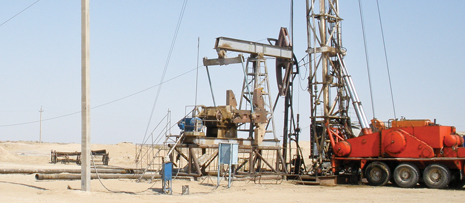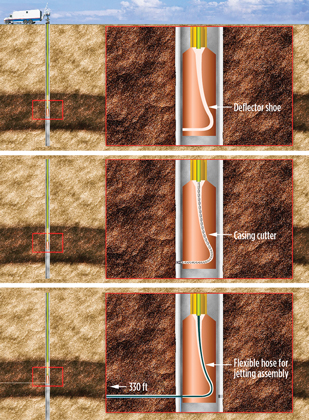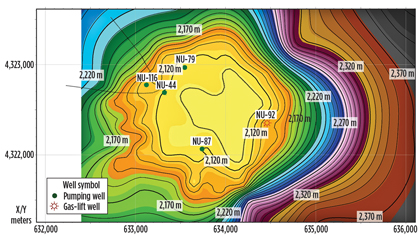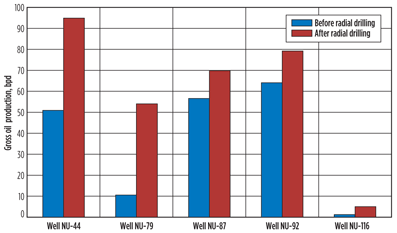STEVE ELLIOTT, Tethys Petroleum
A field trial in Uzbekistan applied radial drilling to access residual oil trapped between existing wells in a mature field.
 |
| At the North Urtabulak oil field in southern Uzbekistan, Tethys Petroleum used its contracted TFI XJ-550 workover rig to prepare the original wellbores before rigging up a coiled-tubing unit to radially drill a series of 330-ft laterals into the reservoir. |
|
The North Urtabulak oil field in southern Uzbekistan was discovered in 1972, with 124.2 million bbl of calculated original oil in place. The field is a carbonate reef structure of Jurassic age, with average reservoir thickness of about 320 m (1,050 ft). To date, 119 wells have been drilled on the structure. A reservoir model in 2010 indicated significant volumes of oil in place, much of it trapped between existing wells. This situation was exacerbated by severe near-wellbore damage and pressure depletion in the reservoir. The operator, Tethys Petroleum, had previously implemented horizontal drilling, sidetracking and acid stimulation to access the remaining reserves, but these technologies were no longer considered cost-effective.
A trial program was conducted in five existing wells using radial drilling, a coiled-tubing workover technique in which lateral holes of 2-in. diameter are drilled up to 330 ft from the original wellbore by high-pressure water jetting. All but one of the five trial wells displayed a significant post-workover uplift in production, leading to overall incremental production of more than 17,000 bbl to date. Based on these results and the low cost compared with previously attempted methods, the operator is planning to expand its use of radial drilling to elsewhere within its Central Asian assets.
BACKGROUND
The effectiveness of radial drilling has long been a contentious issue, and it was in this climate that Tethys Petroleum in 2010 embarked upon a radial drilling campaign to enhance oil recovery from the mature North Urtabulak oil field in Uzbekistan—the first application of the technology in the former Soviet republic. The Central Asia-focused E&P corporation has projects in Kazakhstan, Tajikistan and Uzbekistan, and is the only independent oil and gas company operating in all three countries.
In March 2010, the company’s subsidiary Tethys Production Uzbekistan acquired the contractor rights to the North Urtabulak production enhancement contract. These contracts, awarded by the state-owned oil company Uzbekneftegaz, obligate the contractor to implement new technologies and methods to enhance liquid hydrocarbon production from the field. In return, the contractor receives an allocation of the incremental production.
A Petrel/Eclipse reservoir model of North Urtabulak field commissioned by the operator indicated the presence of 7.3 million bbl of recoverable oil remaining, much of which was trapped between existing wells. Severe near-wellbore skin damage and the pressure-depleted condition of the North Urtabulak reservoir complicated the recovery of this residual oil. A solution was required whereby these remaining oil reserves could be accessed in a cost-effective manner.
Tethys Petroleum and its contractual predecessors had previously implemented horizontal drilling and sidetracking as means of accessing additional oil reserves. However, these capital-intensive and relatively high-risk technologies were no longer considered cost-effective due to the highly depleted state of the North Urtabulak reservoir. Acid stimulation had also been attempted at North Urtabulak, but it was found that the stimulation fluid tended to follow the path of least resistance, which was invariably into the lower-productivity zones of the reservoir. It was hoped that radial drilling would allow the operator to more efficiently access trapped and/or previously inaccessible hydrocarbons.
Radial drilling’s principal application to date has been in marginal and mature fields with low productivity and shallow (less than 9,000 ft) wells. The principal objective of this technique is to improve the production profile around the original wellbore by penetrating beyond the damaged skin zone and accessing trapped pockets of hydrocarbons. At present, this method can only be applied in vertical or near-vertical wells, although research is ongoing to adapt the technology to deviated and horizontal wells. Suitable well candidates for radial drilling are selected, by the operator and the radial drilling contractor, based principally upon the mechanical condition of the well and its production potential.
RADIAL DRILLING METHOD
The operator selected Radial Drilling Services (RDS) as the contractor for its North Urtabulak trial program. The company’s technique applies modified coiled tubing technology and high-pressure water jetting to penetrate lateral holes of 50-mm (2-in.) diameter up to 100 m (330 ft) from the original wellbore. The main components are a jet assembly connected to a 330-ft flexible hose, which is run in hole on coiled tubing, and a specially designed deflector shoe. The shoe contains a channel designed to accept a flexible-drive casing cutter (in cased-hole wells) and then the jetting tool from above, and aim them in a direction perpendicular to the wellbore, Fig. 1.
 |
| Fig. 1. Radial drilling procedure for a single lateral. |
|
Upon selection of suitable well candidates for radial drilling, the well is killed and a workover unit is rigged up. The existing completion string is retrieved, and casing scraper and casing drift assemblies are run in hole. The deflector shoe is then run on production tubing to the reservoir depth and, if needed, is oriented in the desired direction by means of a downhole orientation sub and a gyro. Next, the coiled-tubing unit and gooseneck are rigged up, the casing cutter is run on coiled tubing and through the deflector shoe, and the casing exit is cut.
Finally, the jet assembly is run at the end of the flexible hose, whose other end is connected to the coiled tubing string. The jet assembly is run into the hole and through the deflector shoe, at which point the coiled tubing string is circulated with filtered (to less than 10 microns) water. The high-pressure water is jetted into the formation through jetting nozzles that are selected to match the compressive strength of the formation. As the jetting action penetrates the formation, the coiled tubing continues to run into the hole at a controlled rate, and the jetting assembly moves further into the formation until the entire 330-ft length of the flexible hose has passed through the deflector shoe. The controlled rate at which the coiled tubing string is run, combined with the force of the high-pressure water running though the flexible hose, keeps the jetting string in constant tension so that it penetrates the formation in a straight line perpendicular to the wellbore. In carbonate and carbonate-cemented reservoirs, a 10% hydrochloric acid wash may be applied after drilling the lateral.
After the lateral has been drilled, the deflector shoe is rotated 90° and a second lateral is drilled. This is repeated twice more, resulting in four horizontal laterals of 330-ft length and 2-in. diameter at right angles to one another. The deflector shoe can then be raised to one or more additional target depths in shallower reservoir intervals, and the process repeated.
DRILLING PARAMETERS
A number of radial drilling contractors exist worldwide, mostly using methods similar to that described above. As such, they are all subject to similar mechanical and reservoir/geological parameters, which must be taken into consideration when selecting suitable well candidates for radial drilling operations. The principal mechanical factors affecting radial drilling operations are as follows:
Casing size. Currently available radial drilling equipment can operate in production casing sizes of 5½ in. OD or greater. The equipment can also operate in 4½-in. or greater in-gauge open hole.
Multiple casing strings. Current configurations only allow penetration of single strings of casing. Overlapping casing strings cannot be milled with existing cutting systems.
Casing grade. The tungsten carbide bits used to mill casing exits are limited to casing grades of N-80 (Russian grade D) or less.
Casing wall thickness. The maximum casing wall thickness that the available casing cutters can mill is 10 mm (0.4 in.).
Casing cementation. In order to successfully initiate a casing exit, radial drilling equipment requires a good cement bond between the casing and the formation. A poor casing bond generally results in difficulty or failure in jetting operations. The competence of the cement bond is generally assessed by cement bond logging.
Wellbore inclination. Since the radial drilling system discussed here relies upon gravity to seat the radial drilling assembly in the deflector shoe, the well inclination should not exceed 60° from vertical.
Wellbore depth. Currently available systems are designed to operate at a maximum depth of 3,000 m (9,840 ft).
Wellbore rathole. A rathole of at least 10 m (33 ft) is required to allow the jetted debris to settle beneath the deflector shoe.
Bottomhole conditions. Operating temperatures at reservoir depth shouldn’t exceed 120°C (250°F). Bottomhole pressure should not exceed 6,500 psi.
With regard to reservoir and geological parameters, steeply dipping formations are generally not suitable for radial drilling operations, particularly where there are porosity differences between adjacent formations. Furthermore, facial changes, pinchouts and unconformities often result in stalling or stoppage of the jetting process. Calcitic or siliceous mineralization in carbonates and sands can result in zero porosity, which renders the well unsuitable for radial drilling. Vuggy formations are also generally not suitable for radial drilling, since the forward penetration of the jetting system relies upon some lateral constraint. Likewise, jetting of unconsolidated formations often causes washouts, which impede the forward progress of the jetting assembly. Evaporites such as salts, gypsum and anhydrite are generally not penetrable by jetting action.
APPLICATION AND RESULTS
In the case of the North Urtabulak reservoir, core samples of the reservoir rock were sent to the radial drilling contractor’s laboratory in Houston, Texas, for pilot testing. There, the contractor tested a variety of nozzle types to find the ones best suited to the formation. The coiled-tubing unit was operated in conjunction with Tethys’ contracted TFI XJ450 truck-mounted workover rig.
In total, five well candidates were selected for the radial drilling trial at North Urtabulak field, Fig. 2. These were a combination of cased-hole and openhole completions located in different parts of the field. All wells were vertical or near-vertical. In four of the well candidates, one set of four laterals was attempted; in the fifth well, two sets of four laterals were attempted at two different depths. With the exception of one well where only two laterals were achieved, all of the laterals attempted were successfully drilled to about 330 ft. Immediately after drilling, each lateral was treated with a 10% hydrochloric acid wash. On average, it took less than two hours to complete the radial drilling of each 330-ft lateral at North Urtabulak.
 |
| Fig. 2. Reservoir structure map showing wells selected for radial drilling workover at North Urtabulak field. |
|
The results of radial drilling at North Urtabulak are summarized in Fig. 3. For each of the five trial wells, the pre-workover production rate given is the rate from the last well test prior to radial drilling and the post-workover production given is the stabilized rate after the well had cleaned up, generally one to two weeks after the operation. Similarly to other production enhancement techniques undertaken at North Urtabulak, such as sidetracking and acid stimulation, radial drilling resulted in a marked increase in output followed by gradual decline—a direct consequence of the depleted nature of the reservoir. However, radial drilling cost significantly less in time and money to achieve these results. For example, on a per-well basis, radial drilling took about half the expense and a third of the time of sidetracking.
 |
| Fig. 3. Gross oil production rates for the five pilot wells before and after radial drilling workover. |
|
Well NU-87, an openhole sidetracked well located slightly south of the center of the field, was producing at a gross oil rate of 56.6 bpd prior to radial drilling—326 bpd of total fluid at 82.7% watercut. Four laterals, each 98 m (320 ft) in length, were radially drilled at a depth of 2,450.9 m (8,041 ft). Gross oil production after radial drilling increased 13.2 bpd (23%) to a post-cleanup stabilized rate of 69.8 bpd, the result of decreased watercut due to reduced water coning. The enhanced production was sustained for about one month, after which output returned to its pre-workover level. The well is currently producing 31.0 bpd gross of oil, equivalent to 313 bpd of total fluid at 90.1% watercut.
Well NU-79, a vertical well located slightly north of the center of the field, was the only cased-hole well on which radial drilling operations were performed. Four laterals were radially drilled, each 330 ft in length. Due to difficulties in initiating these laterals, the first two were drilled at 2,436.7 m (7,994 ft) and a further two were drilled deeper in the well, at 2,476.0 m (8,123 ft). It is believed that the problems encountered while drilling the final two laterals were the result of a poor cement bond between the casing and the formation.
Gross oil production from this well saw the largest percentage increase of all the trial wells, up 409% to 54.0 bpd from 10.6 bpd (21.0 bpd of total fluid at 50.5% watercut) before the operation. This increase was far greater, in terms of percentage, than that observed in any of the trial wells except NU-116, which saw a similar percentage increase but in terms of absolute numbers saw the least improvement of any of the wells. It is believed that NU-79’s exceptional response to radial drilling is the result of the well’s placement in a part of the field with very poor reservoir properties, which enhanced the effect of the larger drainage area provided by radial drilling. It is also possible that the poor cement bond contributed the well’s poor pre-workover production and, consequently, its high percentage increase following radial drilling. Although NU-79 has experienced some post-workover decline, it is still producing at an enhanced rate of 37.1 bpd gross of oil (46.5 bpd of fluid at 20.2% watercut), which is 250% higher than the rate before radial drilling.
Well NU-92, an openhole sidetracked well in the eastern area of the field, was producing at a gross oil rate of 64.1 bpd (357 bpd of fluid at 82.0% watercut) before radial drilling. Four radial laterals were drilled, each 330 ft in length, at a depth of 2,457.0 m (8,061 ft). Following the radial drilling operation on Nov. 5, 2010, gross oil production from this well rose to 79.2 bpd—an increase of 15.1 bpd (24%). This increase was due to higher overall fluid production rather than reduced watercut. Like NU-79, this well is still experiencing the enhanced production effected by radial drilling, with a current gross oil rate of 78.1 bpd (454 bpd of fluid at 82.8% watercut).
Well NU-44, an openhole sidetrack in the northwestern part of the field, encountered considerable difficulties in initiating the radial laterals. These difficulties are believed to be the result of previous acidization in the well, which enlarged the wellbore such that it affected the deflector shoe’s ability to centralize within it. Despite this setback, the operator was able to radially drill two laterals in the well at a depth of 2,451.3 m (8,042 ft), one extending 94 m (308 ft) into the reservoir and the other 23 m (75 ft).
Although only two laterals were achieved, gross oil production at this well increased 44 bpd (86%) to 94.9 bpd, from 50.9 bpd (67.9 bpd of fluid at 25% watercut) prior to radial drilling. Enhanced production lasted five months, from October 2010 to March 2011. At present, the well is producing 33.2 bpd gross of oil—64.8 bpd of fluid, nearly the same as before radial drilling, but at a higher watercut of 48.7%.
Well NU-116, a newly drilled vertical well in the northwestern portion of the field, had not produced significant quantities of oil prior to radial drilling, and the consensus is that the well is located in a part of the field with exceptionally low porosity and permeability. It was hoped that laterals drilled from this well might extend beyond the poor-porosity/permeability area and access reserves in a more productive part of the field. In support of this goal, two levels of four radial laterals (330 ft each in length) were drilled from open hole. Despite this high number of laterals compared with the other pilot wells, results have been somewhat disappointing. Gross oil production prior to radial drilling was 1.25 bpd (28.3 bpd of fluid at 95.3% watercut), and after radial drilling it increased only slightly in terms of absolute numbers, to 5 bpd. The current gross oil rate is still slightly higher than the pre-workover rate at 1.45 bpd of oil (30.8 bpd of fluid at 95.4% watercut).
For all five wells, an estimated 17,526 bbl of incremental oil production to date is attributed to the radial drilling program.
DISCUSSION
Overall, the radial drilling trial at North Urtabulak field can reasonably be called a success. With the possible exception of NU-116 (for reservoir-related, rather than operational, reasons), all well candidates in the trial demonstrated a significant uplift in production as a result of radial drilling. While the incremental production from some of these radially drilled wells was not sustained, the operator believes that these reductions were the result of overall decline in reservoir pressure rather than to any operational issues related to the radial drilling process.
By far the most important lesson learned from the radial drilling trial at North Urtabulak field has been that careful field and well selection are paramount to ensure the successful outcome of radial drilling operations. For example, the radial drilling contractor advised the operator during the trial’s planning phase that radial drilling technology is most effective in fields that retain at least 70% of the original reservoir pressure. North Urtabulak field certainly does not fulfill this criterion, which is probably why the post-radial drilling uplift in production was not sustained for some of the wells. While acknowledging this impediment, the operator decided to proceed with the trial in order to demonstrate the method’s effectiveness to Uzbekneftegaz, as a means of securing additional field rehabilitation projects in Uzbekistan and elsewhere.
The only trial wells that experienced problems initiating and progressing radially drilled laterals fell foul of one or more of the well selection criteria outlined above. Specifically, well NU-44 suffered from hole enlargement as a result of a previous acid stimulation, which prevented centralization of the deflector shoe in the wellbore. Similarly, the operator experienced problems initiating laterals in well NU-79 due to a poor cement bond between the casing and the formation. These examples highlight the need for careful planning and well selection prior to the commencement of radial drilling operations.
Despite the pressure-depleted condition of the reservoir, the trial at North Urtabulak field demonstrated that radial drilling can increase production and access trapped hydrocarbons in a cost-effective and time-efficient manner. It allowed accurate placement of laterals and extended horizontal penetration compared with conventional perforating methods. Based on the trial results, the operator plans to implement the technology elsewhere, both in Uzbekistan and within its other assets in Central Asia. 
THE AUTHOR
|
| STEVE ELLIOTT is Project Development Manager for Tethys Petroleum. Prior to joining Tethys, he was employed within the Baker Hughes group of companies for 22 years, working in the North Sea, Africa and Central Asia. Mr. Elliott has detailed knowledge and experience of drilling operations, with a recent focus on project management and the execution and co-ordination of integrated-services contracts. / selliott@tethyspetroleum.com |
|






